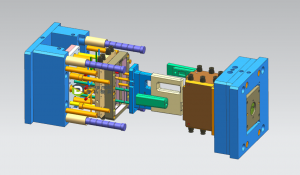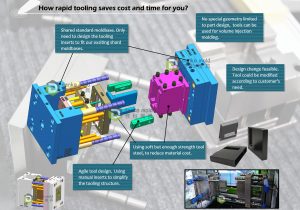As a one-stop manufacturing services supplier, we’ve helped many customers to accomplish their product development in the past years, from initial prototyping, to low-volume production, with our services include rapid tooling & molding, CNC machining, 3D printing, silicone mold vacuum casting, sheet metaling, pressure die casting, etc. Among these, rapid tooling (or call prototype tooling) & injection molding is the maximum invested process in the production development phase, but it is worth.
As we know, prototype can also let product designers to check the appearance, layout of design, fit and tolerance and other details, so why it still worths to build a prototyping tool and do some moldings to verify your new designed product? In this article, we would like to talk about the advantages of rapid tooling & molding for product development:

- The advantages of rapid tooling & molding compare to prototyping:
- Multiple material options and simulate the same material that using in the future molding production. There are also many material choices for prototyping process like CNC machining or silicone mold vacuum casting, such as ABS, PP, POM, Nylon, etc. However, their properties/performance is just close to the final plastic products that produced by injection molding. Especially the vacuum casting parts, any test results based on their mechanical or thermal properties will not be fully trustworthy relative to the final product. We can use the same plastic pellets that used for production molding in rapid tooling, to do the test and the results can be used for reference to check if the material is suitable for the future production.
- Knowing the injection molding issues in advance and improve the product design in time before large volume production. All those surface problem, like shrinkage, sink marks, short shot, gate marks, flow marks, silver marks, etc. can be exposed when we mold the parts with rapid tooling, then we can analyze the reason and do relevant improvement. However, it is impossible to find out these issues when we make the parts by CNC machining, 3D printing or even vacuum casting, because they are totally different processes.
- Lower cost and consistent quality for low volume production. It’s usually more cost-effective when producing small volume parts, such as 100 to 1000 pcs, especially for the complex parts. That’s because the CNC machining cost for each part is much higher, 3D printing take much more time, and vacuum casting need many silicone molds, and it’s hard to ensure all the parts made by these process at the same quality.
- The advantages of rapid tooling & molding compare to conventional/production tooling:
- Flexible tool design and easy to modify. Rapid tooling brings about customization of products due to the flexibility in tool design and the ability to adapt to customer specifications. We deeply knows, prototype tooling is usually for small volume production for verifying products and market testing, product design modification and tool modification is very frequent during the whole product development process.
- Lower cost. The requested life of rapid tooling/prototype tooling is usually only about 5k to 50K, therefore, we normally use “soft” steel such as P20 steel, which is relative cheap but strong enough as the tool material, it’s easier for machining. Secondly, manual inserts and shared mold bases are widely used for rapid tooling, so as to reduce the tool making cost.
- Short lead-time. Based on the items above, material cost and manufacturing cost can be saved accordingly.

In conclusion, when you plan to develop a new plastic product, especially if you need to get several hundreds or thousands of parts to test the selling result, it’s really worth to build a rapid/prototype injection mold, as CNC machining or 3D printing or silicone mold vacuum casting is not cost-effective at this volume.
